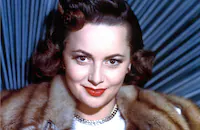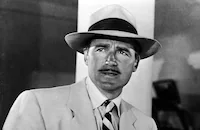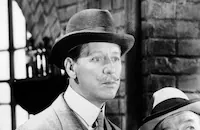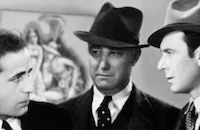It's Love I'm After

Brief Synopsis
Cast & Crew
Archie L. Mayo
Leslie Howard
Bette Davis
Olivia De Havilland
Eric Blore
Patric Knowles
Film Details
Technical Specs

Synopsis
Battling Shakespearean actors Basil Underwood and Joyce Arden perform the death scene from Romeo and Juliet , sniping at each other sotto voce between the lines. In spite of their conflicts, they really are in love and plan to marry that evening. Their plans change, however, when Marcia West, a member of the audience, visits Basil backstage to tell him he is her ideal man. Her distraught fiancé, Henry Grant, begs Basil to attend a house party and act caddishly to Marcia so she will fall out of love with him. Basil agrees, but Joyce, her marriage postponed for the twelfth time, is angry and suspicious. At the house party, Basil's efforts to make Marcia hate him backfire, and he starts to enjoy her attentions. Joyce arrives unexpectedly at the party and catches Basil and Marcia in a romantic moment, even though Digges, Basil's valet, has tried to warn the couple with a series of bird imitations. For revenge, Joyce introduces herself as Basil's wife, but when even this fails to discourage Marcia, she agrees to give Basil a "divorce." Panicked by the thought of losing the only woman he loves, Basil hurries back to his hotel, only to find Marcia there ahead of him. Henry follows and, admitting his love for Marcia, offers to give her up if it will make her happy. She is touched by his gesture and finally realizing that Basil is a bore, leaves gladly with Henry. Joyce sees them in the lobby, understands that they have reconciled and happily agrees to marry Basil at last.

Director

Archie L. Mayo
Cast

Leslie Howard

Bette Davis

Olivia De Havilland

Eric Blore

Patric Knowles

George Barbier

Spring Byington

Bonita Granville
Georgia Caine

Veda Ann Borg

E. E. Clive
Valerie Bergere
Sarah Edwards
Thomas Pogue

Grace Fields
Harvey Clark
Ed Mortimer
Thomas Mills
Lionel Belmore
Ellen Clancy
Patricia Walthall

Rosella Towne
Helen Valkis
Herbert Ashley
Paul Irving
Georgie Cooper

Irving Bacon

Jack Mower
Crew
Harry Joe Brown
Leo F. Forbstein
Maurice Hanline
Maurice Hanline
Margaret Le Vino
Robert B. Lee
Owen Marks
Orry-kelly
Casey Robinson
Heinz Roemheld
Jack Sullivan
James Van Trees
Jack L. Warner
Carl Weyl
Crane Wilbur

Videos
Movie Clip





Trailer
Film Details
Technical Specs

Articles
It's Love I'm After
Bette Davis as Joyce Arden in It's Love I'm After
With Annette Bening's recent triumph as a stage diva fighting to keep career, husband and lover in Being Julia (2004), the time is ripe for a remake of this sparkling, stage-centered screwball comedy from 1937. It even doubles the comic impact of Bening's film with not one but two divas battling for center stage and romance.
It's Love I'm After was initiated by Leslie Howard, who after heavy dramatic roles in The Petrified Forest (1936), Romeo and Juliet (1936) and most of his other films, demanded a comic change of pace for his next picture at Warner Bros. Despite some misgivings at the executive level about Howard's ability to play comedy, producer Hal Wallis reluctantly accepted Howard's suggestion that he film the story "Gentleman After Midnight," all about a matinee idol who takes time from romantic sparring with his leading lady to try to cure a young female fan of her mindless devotion to him. Casey Robinson fashioned a witty screenplay that gave Howard the chance to drop comic zingers, swashbuckle through the grounds of a posh Pasadena mansion and spoof his Romeo and Juliet when he and his leading lady perform the play's final scene while whispering insults to each other.
Finding the right leading lady was a major problem, however. Howard wanted a skilled comic actress from the stage, pushing for either Gertrude Lawrence or Ina Claire. Neither had a particularly large film following but Wallis arranged for director Archie Mayo to meet with Lawrence to discuss the role. She was interested and Mayo thought she could do it, but Wallis refused to commit to her, testing several other actresses with Howard. Then he and Howard saw Lawrence in the British film Men Are Not Gods (1936), and both had to admit she didn't photograph well. With a start date already set, the picture went into production without a leading lady.
Finally, Wallis decided that Bette Davis could use a change of pace after intensely dramatic roles in Marked Woman, Kid Galahad and That Certain Woman (all 1937). She had her misgivings, though. Having churned out those films with little break, she was aching for a vacation. She also complained that the script favored Howard's role while the more interesting female role was the foolish society girl in love with him, being played by Olivia de Havilland. Moreover, she hated to cede sole above-the-title billing to Howard. Finally, Wallis convinced her the change of pace and the chance to make her third film with Howard (they had teamed for Of Human Bondage in 1934 and The Petrified Forest) would add to her prestige. One concession he would make later was agreeing to replace cinematographer James Van Trees with Tony Gaudio, one of the few cameramen Davis trusted to photograph her under her exacting standards.
Another of Davis's concerns was her rocky relationship with Howard off-screen. While filming Of Human Bondage, he had been cold and dismissive, resenting an American actress being cast in what he considered a very British story. Her dramatic triumph in the film had won his respect, but he had run hot and cold while filming The Petrified Forest, sometimes ignoring her, sometimes coming on to her rather crudely. The latter was hardly a problem on It's Love I'm After. Instead, he turned his attentions to de Havilland, driving her mad with his dogged persistence.
On-screen, however, the comic types meshed perfectly. Critics not only praised Howard and Davis for playing against type, but hailed the film's strong supporting cast, filled with eccentric comic actors -- including the ultimate gentleman's gentleman Eric Blore, blustering father George Barbier, and dizzy society matron Spring Byington. Any doubts about Howard's comic abilities were silenced by the film's impressive box office performance, bringing in over a million dollars during its initial release, and Howard's next hit, directing himself in George Bernard Shaw's classic comedy Pygmalion (1938).
Producer: Hal B. Wallis, Harry Joe Brown
Director: Archie Mayo
Screenplay: Casey Robinson, based on the story "Gentleman After Midnight" by Maurice Hanline
Cinematography: James Van Trees, Tony Gaudio (uncredited)
Art Direction: Carl Jules Weyl
Music: Heinz Roemheld
Cast: Leslie Howard (Basil Underwood), Bette Davis (Joyce Arden), Olivia de Havilland (Marcia West), Eric Blore (Digges), Patric Knowles (Henry Grant), George Barbier (William West), Spring Byington (Aunt Ella Paisley), Bonita Granville (Gracie Kane), E. E. Clive (Butler), Veda Ann Borg (Elsie).
BW-91m. Closed captioning.
by Frank Miller

It's Love I'm After
Quotes
After all, what am I? Just the greatest actor in the world.- Basil Underwood
You're going to have love for breakfast, love for luncheon and love for dinner. Sweet, sugary, sticky worship. You're going to have a steady diet of it till you're ready to scream - you billygoat!- Joyce Arden
Aunt Ella, when Basil Underwood feels like a kipper, I'm sure he doesn't feel like an egg - even an aristocratic one.- Marcia West
Have you seen a mad woman 'round here?- Basil Underwood
Which one sir?- Butler
Trivia
Notes
The film's working title was A Gentleman After Midnight.















